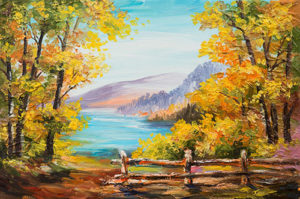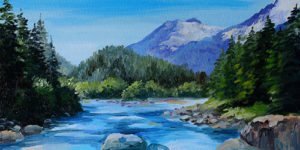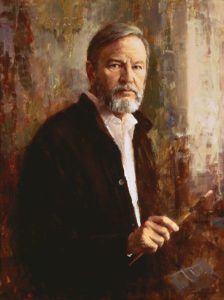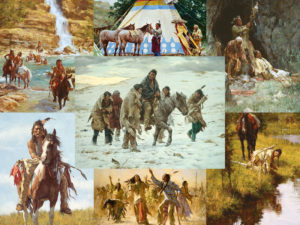 Did you know earlier American landscape painters used landscapes as a background for portraitures? At the turn of the 19th century, it became a vehicle for representing American painting.
Did you know earlier American landscape painters used landscapes as a background for portraitures? At the turn of the 19th century, it became a vehicle for representing American painting.
In the beginning, the painters were influenced by the painting style of Europe and the old masters. Later on, styles and genres unique to the country were born.
The US, landscape painting played an essential part in shaping its identity as it is now. A vast amount of painters made their way to the wild nation and began to record its beautiful vistas and stunning panoramas.
Our article brings to you a guide containing a list of the best and famous American landscape painters, modern and contemporary artists, the legendary Hudson River School, and much more.
What Makes a Landscape Painting?
Any painting or artwork that depicts nature in all its glory is a landscape painting. It focuses on natural scenery such as rivers, valleys, mountains, cliffs, forests, trees, etc.
A landscape can be painted realistically to replicate the scenery as close as possible, or it can be an abstract painting with a deeper meaning.
Apart from that, it can also be an imaginary depiction with a dream-like quality. Moreover, it can also be a riverscape, seascape, cloudscape, and cityscape.
History of American Landscape Painting
Though landscape painting did not emerge as a separate genre until the renaissance period (16th century) in Europe, you can trace it back to the 4th century in China.
Whilst in Europe, it started primarily during the Dutch Golden Age in the 17th century. From being seen as the background in sketches of wealthy individuals, it came into the forefront after being embraced by the romantic painters in the 18th and 19th centuries.
Landscapes grew famous in American art in the early nineteenth century. American painters chronicled the vast wilderness that was America and the boundless prospects. When the expansion pushed westward, they recorded the disappearing landscape and the expanding cityscape. It served as a reminder of industrial development and the price of progress.
The latter half of the 19th century, the painters from the Hudson River School led by Thomas Cole set to create works that narrated the vastness of the landscape, emphasizing the raw power of nature. The Yellowstone Collection by Thomas Moran helped persuade Congress to set aside the area as a national park which exists until today.
By the 20th century, the romantic views of nature were replaced by the urban scenes by a group of New York artists led by Robert Henri.
Since then, American landscape painters influenced by abstract expressionism and cubism have portrayed landscapes in various approaches.
Best Landscape Painter
The best and most famous painter in the history of landscape painting is Vincent Van Gogh, a Dutch post-impressionist painter.
Among his 2100 paintings, 860 were oil paintings. Though he drew still-life, portraits, he is well known for his imaginative landscape paintings.
His unique use of bold colors, rough beauty, and creative brush works impressed scores of people and made him famous for over 100 years. His most celebrated work is The Starry Night(1889).
Famous American Landscape Painters
Landscape painters gained interest and favor worldwide only in the last 2 – 3 centuries. Since then, American painters have garnered the art community’s attention with their realism and abstract expressionism.
Please note that the painters mentioned do not belong to the Hudson River School. They are discussed later in the article.
Winslow Homer
Winslow Homer was one of the prominent painters of 19th century America. He is famous for his marine landscapes and illustration. While he primarily worked with watercolors, he also created stunning works of art on oil canvas.
Though he was an illustrator in his early life, he exclusively drew landscapes and watercolors, primarily rural scenery, idyllic farm life, children playing, etc.
His notable paintings include: Breezing Up (1876), Snap-the-Whip (1872)
Georgia O’Keeffe
Georgia O’Keeffe is one of the most prominent landscape painters of the 20th century and the only woman on this list. She is well known for her paintings of New York skyscrapers and the landscape. The latter was inspired by the panorama of New Mexico, the mountain peaks of Peru, Japan’s Mount Fuji, among a few others. In addition, she also painted close-up paintings of flowers.
Her famous paintings include: Jimson Weed (1936), Black Iris (1926), My Shanty, Lake George (1922)
William Morris Hunt
William Morris Hunt is a famous nineteenth-century American portrait and landscape artist. He is one of the painters who traveled to Europe to learn the art and is one of the most influential painters.
Upon returning, William Hunt introduced the works of Barbizon school and Théodore Rousseau, thereby bringing a change turning a new generation of painters away from the Hudson River School. Hunt was also a prolific sculptor and a lithographer.
His prominent works include: Hillside with Trees (oil on canvas 1872-1878), Niagara Falls (1878)
George Innes
Often called the “Father of American Landscape Painting,” George Innes is known for his mature work and usage of color, light, and shadow. He displayed a uniquely American style and complex sceneries that often mixed hazy elements with refined details.
Though he was in the same era as Hudson River School, he differentiated himself to a profound degree. He later followed the Barbizon school yet adapted to a highly personal style.
His notable works of art include: Autumn Oaks (1878), The Lackawanna Valley (1856)
William Merritt Chase
William Merritt Chase was a follower of the impressionist style of painting which he learned from the old masters of Munich, Germany. He painted in all media, oil on canvas, watercolors, pastels, and etchings.
His works include both portrait and landscape, again impressionist in manner. Some of his important paintings are: Shinnecock (1896), At The Seaside (1898)
First American Landscape Painter
Winthrop Chandler is credited for being the first American artist to paint landscapes. There have been no recorded artists before his time.
Chandler used a variety of art mediums, including carving, gilding, portraiture, illustration, and landscape. The two available paintings by the artist are on plaster.
Works attributed to Winthrop Chandler are Homestead of General Timothy Ruggles of Hardwick (1770) and an overmantel from Elisha Hurlbut House (1767-1769), General Samuel McClellan House (1758-1761), Battle of Bunker Hill (1776-1777), overmantel from Rev. Aaron Putnam’s Parsonage (1777).
Best American Landscape Painter
Thomas Cole is considered the best among America’s painters and the leading painter in the early 19th century. While he portrayed the Hudson River Valley in minute detail, he also created sublime imaginary vistas with clever use of light.
Above all, he, most importantly, is the founder of the famous Hudson River School.
Modern and Contemporary American Landscape Artists
 Given the history of landscape paintings, it is not surprising that artists dabble in it even today, albeit with a more contemporary and modern outlook.
Given the history of landscape paintings, it is not surprising that artists dabble in it even today, albeit with a more contemporary and modern outlook.
Here are the famous modern landscape artists of today:
- Hernan Bas – A Landscape to Swallow You Whole (2011)
- Amy Bennett – Nothing New under the Sun (2016)
- Clyde Aspevig – Winter Vibrations, Blooming Sage
- Enrique Martinez Celaya – The Empire (2015)
- Pat De Groot – Spring Blue (2004)
- Wayne Thiebaud – Green River Lands (1998)
- Richard Diebenkorn – Cityscape (1963)
Early American Landscape Artists
Earlier American artists delved into the unchartered area of painting landscapes and played a crucial part in the emergence of landscape as a genre in American painting in the 19th century.
- Thomas Doughty – In the Catskills, On the Hudson
- Thomas Birch – Philadelphia Harbor, New York Harbor, The Narrows, New York Bay
- James Peale – Pleasure Party by a Mill
- William Russell Birch – The City of New York, Sweet Briar
- Joshua Shaw – The First Ship, The Pioneers
- William Thompson Russell Smith – Susquehanna River View, Lake Winnipesaukee
Impact of Hudson River School in American Art
Hudson River School is an art movement influenced by romanticism. It is comprised of New York City-based landscape painters inspired by the untamed Hudson River and its surroundings.
Thomas Cole is the acknowledged founder of this movement. He fostered the next generation of painters, such as Frederic Edwin Church, who became famous artists of their era.
Hudson River School was fueled by Ralph Waldo Emerson, “and by the conviction that God had given the American people an abundance of natural resources as a source of wealth and prosperity.”
The movement itself inspired its painters to be free of the European school of painting and be independent. Furthermore, it was a celebration of the natural beauty of America and the nationalistic approach.
Hudson River School painters often created works of art that depicted the raw, alluring sublime beauty of the northeast. Later artists like Bierstadt and Moran explored the American west and sketched the Rocky Mountains, Yosemite Valley, and the Grand Canyon. The American landscape paintings depicted a critical time in the history of the country and the development of the native art culture.
The Hudson River School remained dominant throughout the 19th century, inspiring scores of artists.
Hudson River School Painters
Hudson River School painters came from all parts of the country attracted towards the allure of the open and primitive landscapes. Though they all were trained in Europe, they reached some measure of success in their home country.
Below are some of the famous and established painters of Hudson River School:
Thomas Cole
Thomas Cole is well-known for his romantic portrayals of the American wilderness. Apart from that, he is renowned for being the founder of the “Hudson River School” which played a critical role in developing the landscape genre.
Cole’s landscapes gave Americans a source of pride in their wild country. He spurred many young American painters like Durand and Church through the civil war era.
His famous paintings include; The Oxbow (1836), Niagara Falls (1930), Kaaterskill Falls (1826)
Albert Bierstadt
Albert Bierstadt is a German-American artist who is well-known for his sweeping landscapes, primarily of the American West. He traveled westwards and chronicled the sceneries along his journey. While he was not the first artist to record the vistas, he is the foremost one among the many others.
He later became a part of the second-generation painters of the Hudson River School and also the Rocky Mountain School.
His notable paintings include: Valley of the Yosemite (1864), Rocky Mountain Landscape (1870)
John William Casilear
John William Casilear is a renowned American artist belonging to the Hudson River School. Initially, he trained as an engraver with Durand but then turned his attention to painting, mainly landscapes.
Around 1940 he accompanied a few painters to Europe, where he created works of art and sketches of nature. John William Casilear traveled across the world again, this time in 1957, regularly painting.
His notable works include: Autumn Landscape with Fisherman (1865-70), Lake George (1857)
Frederic Edwin Church
Frederic Edwin Church is probably the most prominent and central figure in the Hudson River School. His paintings are large, realistic, and emphasized details and light. He is well-known for depicting picturesque views like mountains, sunsets, and waterfalls.
Moreover, he is also a student of Cole’s under whom he studied at his studio in Catskill, New York. He also accompanied the master in his travels to the Catskill mountains for sketching sessions.
Frederic Edwin Church was a traveler. He traveled to South America, Great Britain, the North Atlantic between Labrador and Greenland, etc.
His important works include: Niagara Falls (1867), The Heart of the Andes (1859), Aurora Borealis (1865)
Asher Brown Durand
Asher Brown Durand was one of the celebrated artists of the Hudson River School. He took on the mantle of an engraver and illustrator and moving on to painting landscapes. He traveled to Europe in 1840-41 to study the art and the old masters, much like the artists then.
Upon his return, he took up painting the romantic landscapes of the Hudson River area, the Adirondack Mountains, and New England. He is one of the first to work in nature. His most famous work Kindred Spirits (1849), set in the Catskill forest, takes on an exciting yet precise interpretation of the natural world.
His other famous paintings include: River Scene (1854), High Point: Shandaken Mountains (1853), The Beeches (1845), Summer Afternoon (1865)
Thomas Moran
Famous for his Yellowstone and Rocky mountain paintings, Thomas Moran is a part of the Hudson River School and the Rocky Mountain School. He is best remembered for his idealization of the American West.
By 1871, he set out to document the panorama of the region, the geysers, canyons, hot springs, cliffs, etc. This led to the Yellowstone national park being created.
His most important works of art include The Grand Canyon of the Yellowstone (1893–1901), The Chasm of Colorado (1872)
Other painters of note are Jasper Francis Cropsey, John Frederick Kensett, Sanford Robinson Gifford, Henry Augustus Ferguson, George Henry, James David, John Hudson, and many more.
Conclusion
American landscape painting was not just a representation of nature. It is a historical record of the world as it was then. Furthermore, it is also a key to the religious and political beliefs of a budding nation.
You can find the gems from the masters of landscapes at the National Gallery of Art and The Metropolitan Museum of Art. Apart from that, the estates of the painters like Cole have their own museums portraying the life and works of the artist.
 Fine Art Publishing has a vast collection of artwork from nationally-acclaimed and world-famous American landscape painters. Contact us if you’d like to see or purchase any of these limited-edition prints or paintings.
Fine Art Publishing has a vast collection of artwork from nationally-acclaimed and world-famous American landscape painters. Contact us if you’d like to see or purchase any of these limited-edition prints or paintings.
 Howard Terpning is an American painter and illustrator known for his paintings of the Native Americans. He is considered a true master by his peers, collectors, and admirers of the American west.
Howard Terpning is an American painter and illustrator known for his paintings of the Native Americans. He is considered a true master by his peers, collectors, and admirers of the American west. In 1977, Terpning moved to Tuscon to chronicle the Native American culture focussing on the American West and Plains Indians.
In 1977, Terpning moved to Tuscon to chronicle the Native American culture focussing on the American West and Plains Indians. Fine Art Publishing has a vast collection of artwork from nationally-acclaimed and world-famous western art painters like Howard Terpning. Shop his vast collection of beautiful paintings in his complete catalog today!
Fine Art Publishing has a vast collection of artwork from nationally-acclaimed and world-famous western art painters like Howard Terpning. Shop his vast collection of beautiful paintings in his complete catalog today! Did you know earlier American landscape painters used landscapes as a background for portraitures? At the turn of the 19th century, it became a vehicle for representing American painting.
Did you know earlier American landscape painters used landscapes as a background for portraitures? At the turn of the 19th century, it became a vehicle for representing American painting. Given the history of landscape paintings, it is not surprising that artists dabble in it even today, albeit with a more
Given the history of landscape paintings, it is not surprising that artists dabble in it even today, albeit with a more